stop start KIA Sorento 2006 1.G Owner's Manual
[x] Cancel search | Manufacturer: KIA, Model Year: 2006, Model line: Sorento, Model: KIA Sorento 2006 1.GPages: 312, PDF Size: 5.21 MB
Page 6 of 312
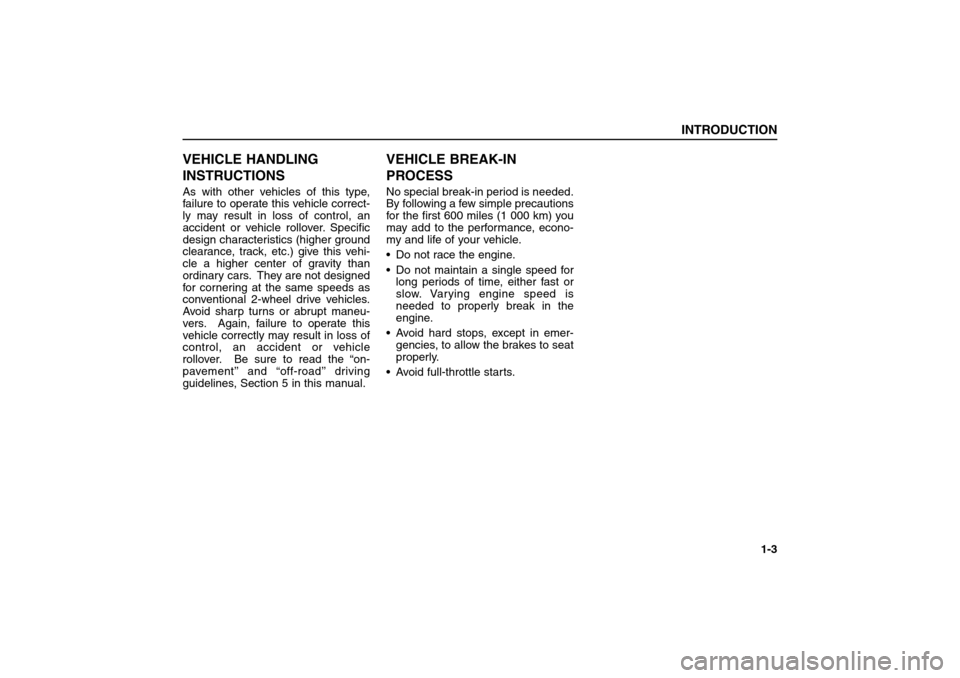
VEHICLE HANDLING
INSTRUCTIONSAs with other vehicles of this type,
failure to operate this vehicle correct-
ly may result in loss of control, an
accident or vehicle rollover. Specific
design characteristics (higher ground
clearance, track, etc.) give this vehi-
cle a higher center of gravity than
ordinary cars. They are not designed
for cornering at the same speeds as
conventional 2-wheel drive vehicles.
Avoid sharp turns or abrupt maneu-
vers. Again, failure to operate this
vehicle correctly may result in loss of
control, an accident or vehicle
rollover. Be sure to read the “on-
pavement’’ and “off-road’’ driving
guidelines, Section 5 in this manual.
VEHICLE BREAK-IN
PROCESSNo special break-in period is needed.
By following a few simple precautions
for the first 600 miles (1 000 km) you
may add to the performance, econo-
my and life of your vehicle.
Do not race the engine.
Do not maintain a single speed for
long periods of time, either fast or
slow. Varying engine speed is
needed to properly break in the
engine.
Avoid hard stops, except in emer-
gencies, to allow the brakes to seat
properly.
Avoid full-throttle starts.
INTRODUCTION
1-3
BL-ENG (CAN)-1.qxd 8/8/2005 10:42 AM Page 3
Page 12 of 312
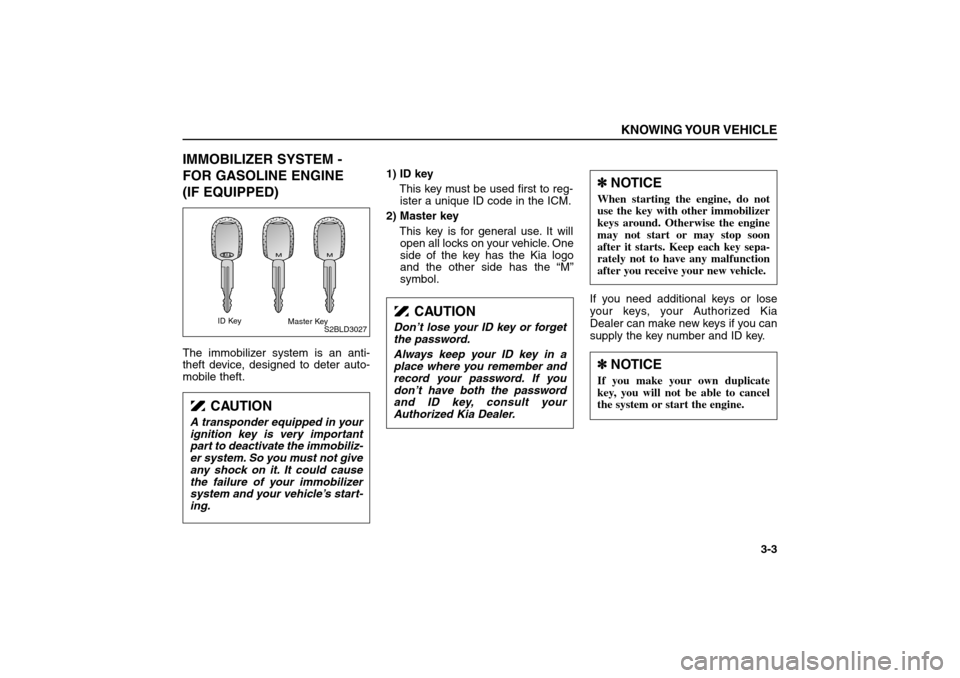
IMMOBILIZER SYSTEM -
FOR GASOLINE ENGINE
(IF EQUIPPED)The immobilizer system is an anti-
theft device, designed to deter auto-
mobile theft.1) ID key
This key must be used first to reg-
ister a unique ID code in the ICM.
2) Master key
This key is for general use. It will
open all locks on your vehicle. One
side of the key has the Kia logo
and the other side has the “M”
symbol.
If you need additional keys or lose
your keys, your Authorized Kia
Dealer can make new keys if you can
supply the key number and ID key.
KNOWING YOUR VEHICLE
3-3
M
M
CAUTION
Don’t lose your ID key or forget
the password.
Always keep your ID key in a
place where you remember and
record your password. If you
don’t have both the password
and ID key, consult your
Authorized Kia Dealer.
CAUTION
A transponder equipped in your
ignition key is very important
part to deactivate the immobiliz-
er system. So you must not give
any shock on it. It could cause
the failure of your immobilizer
system and your vehicle’s start-
ing.
S2BLD3027
✽ ✽
NOTICEIf you make your own duplicate
key, you will not be able to cancel
the system or start the engine.✽ ✽
NOTICEWhen starting the engine, do not
use the key with other immobilizer
keys around. Otherwise the engine
may not start or may stop soon
after it starts. Keep each key sepa-
rately not to have any malfunction
after you receive your new vehicle.
ID Key
Master Key
BL-ENG (CAN)-3.qxd 7/28/05 5:52 PM Page 3
Page 91 of 312
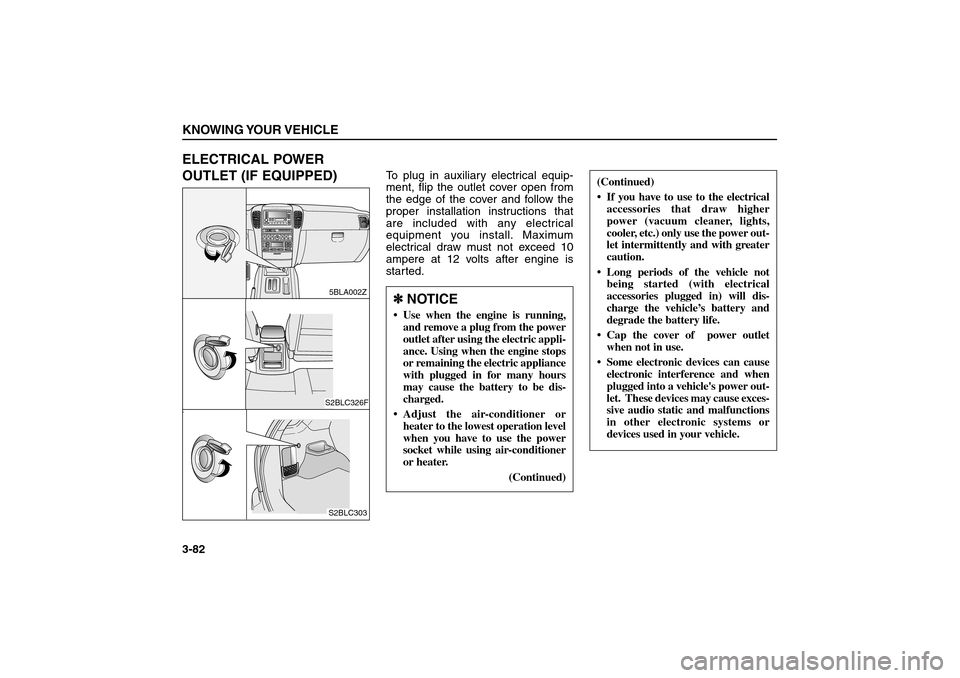
ELECTRICAL POWER
OUTLET (IF EQUIPPED)
To plug in auxiliary electrical equip-
ment, flip the outlet cover open from
the edge of the cover and follow the
proper installation instructions that
are included with any electrical
equipment you install. Maximum
electrical draw must not exceed 10
ampere at 12 volts after engine is
started.
KNOWING YOUR VEHICLE3-82
P
R
N
D2LH
M
5BLA002ZS2BLC326FS2BLC303
(Continued)
If you have to use to the electrical
accessories that draw higher
power (vacuum cleaner, lights,
cooler, etc.) only use the power out-
let intermittently and with greater
caution.
Long periods of the vehicle not
being started (with electrical
accessories plugged in) will dis-
charge the vehicle’s battery and
degrade the battery life.
Cap the cover of power outlet
when not in use.
Some electronic devices can cause
electronic interference and when
plugged into a vehicle's power out-
let. These devices may cause exces-
sive audio static and malfunctions
in other electronic systems or
devices used in your vehicle.
✽ ✽
NOTICE Use when the engine is running,
and remove a plug from the power
outlet after using the electric appli-
ance. Using when the engine stops
or remaining the electric appliance
with plugged in for many hours
may cause the battery to be dis-
charged.
Adjust the air-conditioner or
heater to the lowest operation level
when you have to use the power
socket while using air-conditioner
or heater.
(Continued)
BL-ENG (CAN)-3.qxd 7/28/05 5:52 PM Page 82
Page 104 of 312
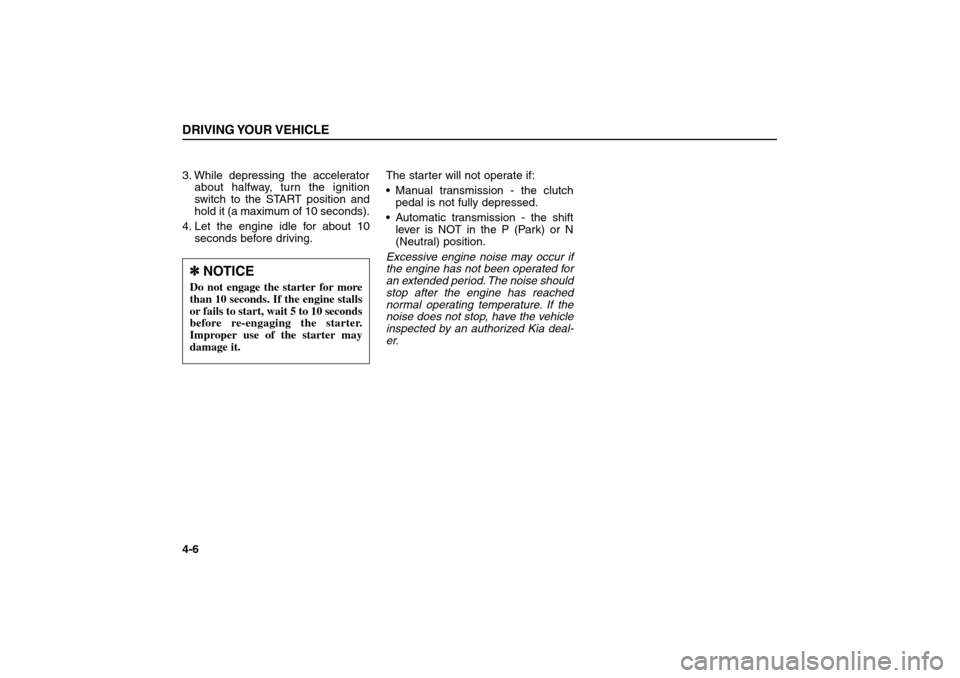
3. While depressing the accelerator
about halfway, turn the ignition
switch to the START position and
hold it (a maximum of 10 seconds).
4. Let the engine idle for about 10
seconds before driving.The starter will not operate if:
Manual transmission - the clutch
pedal is not fully depressed.
Automatic transmission - the shift
lever is NOT in the P (Park) or N
(Neutral) position.
Excessive engine noise may occur if
the engine has not been operated for
an extended period. The noise should
stop after the engine has reached
normal operating temperature. If the
noise does not stop, have the vehicle
inspected by an authorized Kia deal-
er.DRIVING YOUR VEHICLE4-6✽ ✽
NOTICEDo not engage the starter for more
than 10 seconds. If the engine stalls
or fails to start, wait 5 to 10 seconds
before re-engaging the starter.
Improper use of the starter may
damage it.
BL-ENG (CAN)-4.qxd 7/28/05 5:55 PM Page 6
Page 117 of 312
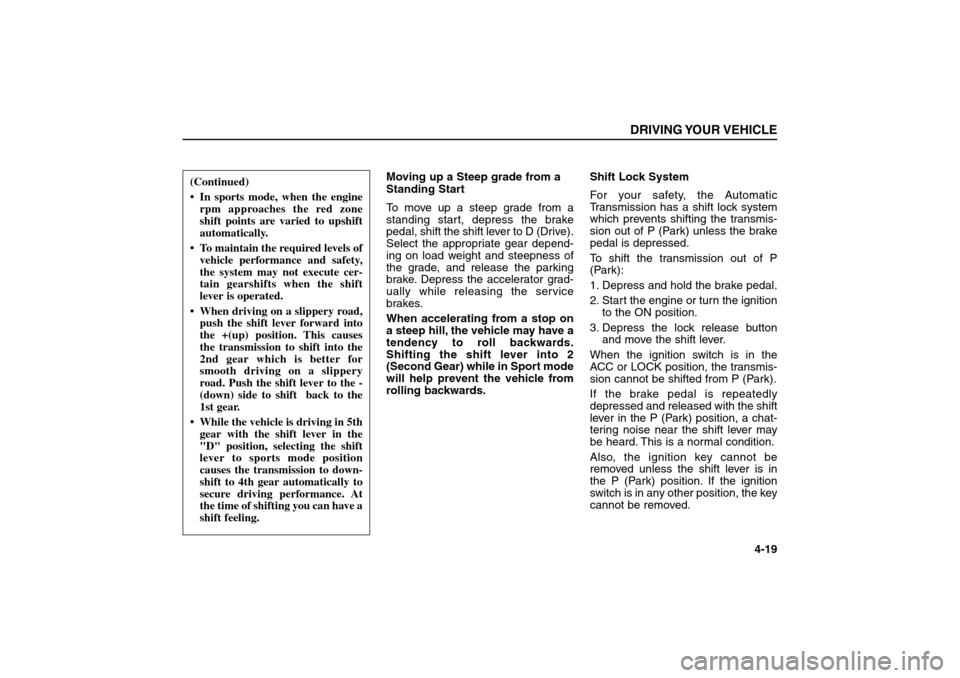
Moving up a Steep grade from a
Standing Start
To move up a steep grade from a
standing start, depress the brake
pedal, shift the shift lever to D (Drive).
Select the appropriate gear depend-
ing on load weight and steepness of
the grade, and release the parking
brake. Depress the accelerator grad-
ually while releasing the service
brakes.
When accelerating from a stop on
a steep hill, the vehicle may have a
tendency to roll backwards.
Shifting the shift lever into 2
(Second Gear) while in Sport mode
will help prevent the vehicle from
rolling backwards.Shift Lock System
For your safety, the Automatic
Transmission has a shift lock system
which prevents shifting the transmis-
sion out of P (Park) unless the brake
pedal is depressed.
To shift the transmission out of P
(Park):
1. Depress and hold the brake pedal.
2. Start the engine or turn the ignition
to the ON position.
3. Depress the lock release button
and move the shift lever.
When the ignition switch is in the
ACC or LOCK position, the transmis-
sion cannot be shifted from P (Park).
If the brake pedal is repeatedly
depressed and released with the shift
lever in the P (Park) position, a chat-
tering noise near the shift lever may
be heard. This is a normal condition.
Also, the ignition key cannot be
removed unless the shift lever is in
the P (Park) position. If the ignition
switch is in any other position, the key
cannot be removed.
DRIVING YOUR VEHICLE
4-19
(Continued)
In sports mode, when the engine
rpm approaches the red zone
shift points are varied to upshift
automatically.
To maintain the required levels of
vehicle performance and safety,
the system may not execute cer-
tain gearshifts when the shift
lever is operated.
When driving on a slippery road,
push the shift lever forward into
the +(up) position. This causes
the transmission to shift into the
2nd gear which is better for
smooth driving on a slippery
road. Push the shift lever to the -
(down) side to shift back to the
1st gear.
While the vehicle is driving in 5th
gear with the shift lever in the
"D" position, selecting the shift
lever to sports mode position
causes the transmission to down-
shift to 4th gear automatically to
secure driving performance. At
the time of shifting you can have a
shift feeling.
BL-ENG (CAN)-4.qxd 7/28/05 5:55 PM Page 19
Page 118 of 312
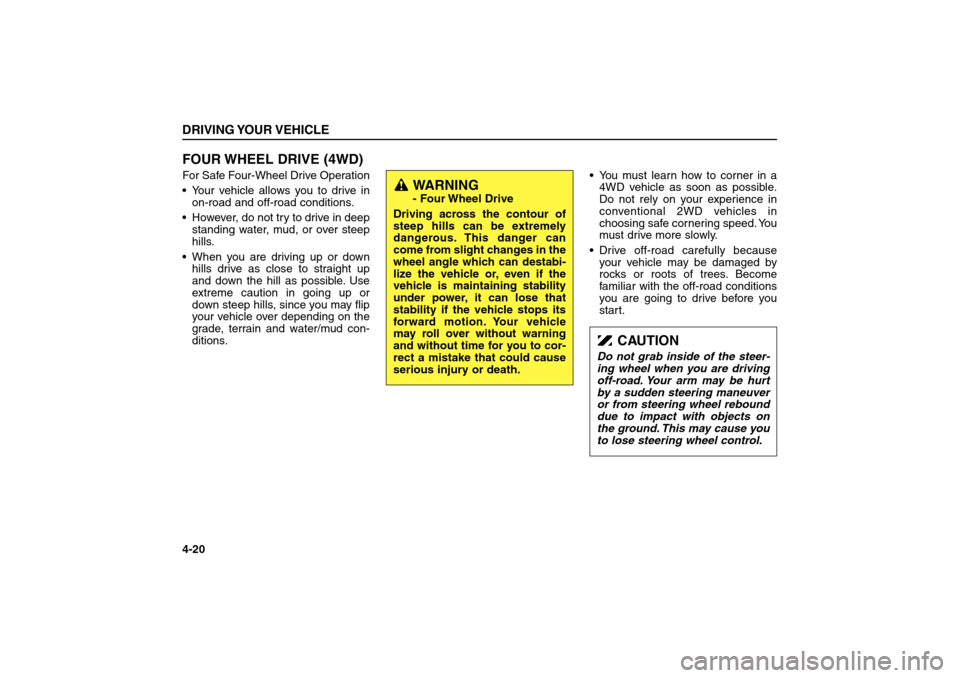
FOUR WHEEL DRIVE (4WD)For Safe Four-Wheel Drive Operation
Your vehicle allows you to drive in
on-road and off-road conditions.
However, do not try to drive in deep
standing water, mud, or over steep
hills.
When you are driving up or down
hills drive as close to straight up
and down the hill as possible. Use
extreme caution in going up or
down steep hills, since you may flip
your vehicle over depending on the
grade, terrain and water/mud con-
ditions.You must learn how to corner in a
4WD vehicle as soon as possible.
Do not rely on your experience in
conventional 2WD vehicles in
choosing safe cornering speed. You
must drive more slowly.
Drive off-road carefully because
your vehicle may be damaged by
rocks or roots of trees. Become
familiar with the off-road conditions
you are going to drive before you
start.DRIVING YOUR VEHICLE4-20
WARNING- Four Wheel Drive
Driving across the contour of
steep hills can be extremely
dangerous. This danger can
come from slight changes in the
wheel angle which can destabi-
lize the vehicle or, even if the
vehicle is maintaining stability
under power, it can lose that
stability if the vehicle stops its
forward motion. Your vehicle
may roll over without warning
and without time for you to cor-
rect a mistake that could cause
serious injury or death.
CAUTION
Do not grab inside of the steer-
ing wheel when you are driving
off-road. Your arm may be hurt
by a sudden steering maneuver
or from steering wheel rebound
due to impact with objects on
the ground. This may cause you
to lose steering wheel control.
BL-ENG (CAN)-4.qxd 7/28/05 5:55 PM Page 20
Page 125 of 312
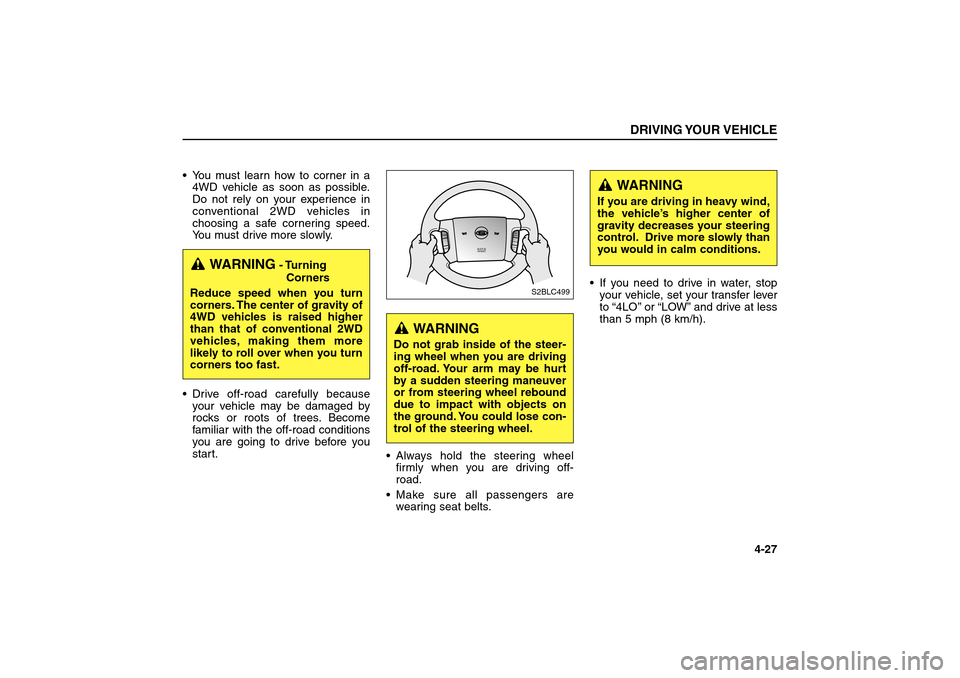
You must learn how to corner in a
4WD vehicle as soon as possible.
Do not rely on your experience in
conventional 2WD vehicles in
choosing a safe cornering speed.
You must drive more slowly.
Drive off-road carefully because
your vehicle may be damaged by
rocks or roots of trees. Become
familiar with the off-road conditions
you are going to drive before you
start.
Always hold the steering wheel
firmly when you are driving off-
road.
Make sure all passengers are
wearing seat belts.If you need to drive in water, stop
your vehicle, set your transfer lever
to “4LO’’or “LOW”and drive at less
than 5 mph (8 km/h).
DRIVING YOUR VEHICLE
4-27
WARNING
- Turning
Corners
Reduce speed when you turn
corners. The center of gravity of
4WD vehicles is raised higher
than that of conventional 2WD
vehicles, making them more
likely to roll over when you turn
corners too fast.
WARNING
Do not grab inside of the steer-
ing wheel when you are driving
off-road. Your arm may be hurt
by a sudden steering maneuver
or from steering wheel rebound
due to impact with objects on
the ground. You could lose con-
trol of the steering wheel.
WARNING
If you are driving in heavy wind,
the vehicle’s higher center of
gravity decreases your steering
control. Drive more slowly than
you would in calm conditions.
SRSAIRBAG
R
E
S
A
C
C
E
LC
O
A
S
T
S
E
T
PWRSEEK
CANCEL
S2BLC499
BL-ENG (CAN)-4.qxd 7/28/05 5:55 PM Page 27
Page 126 of 312
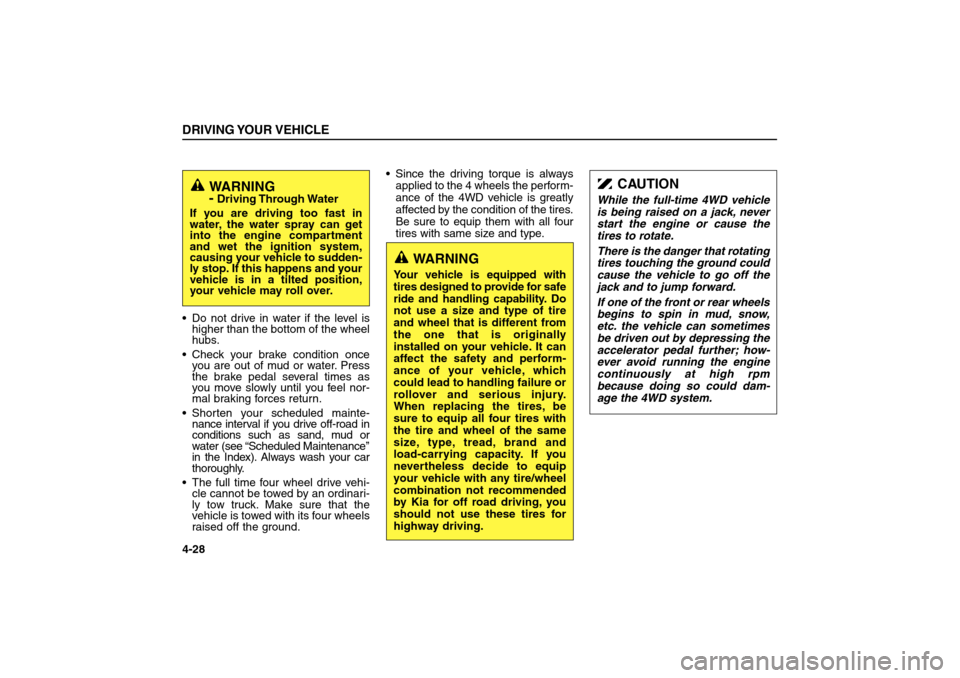
Do not drive in water if the level is
higher than the bottom of the wheel
hubs.
Check your brake condition once
you are out of mud or water. Press
the brake pedal several times as
you move slowly until you feel nor-
mal braking forces return.
Shorten your scheduled mainte-
nance interval if you drive off-road in
conditions such as sand, mud or
water (see “Scheduled Maintenance’’
in the Index). Always wash your car
thoroughly.
The full time four wheel drive vehi-
cle cannot be towed by an ordinari-
ly tow truck. Make sure that the
vehicle is towed with its four wheels
raised off the ground.Since the driving torque is always
applied to the 4 wheels the perform-
ance of the 4WD vehicle is greatly
affected by the condition of the tires.
Be sure to equip them with all four
tires with same size and type.DRIVING YOUR VEHICLE4-28
CAUTION
While the full-time 4WD vehicle
is being raised on a jack, never
start the engine or cause the
tires to rotate.
There is the danger that rotating
tires touching the ground could
cause the vehicle to go off the
jack and to jump forward.
If one of the front or rear wheels
begins to spin in mud, snow,
etc. the vehicle can sometimes
be driven out by depressing the
accelerator pedal further; how-
ever avoid running the engine
continuously at high rpm
because doing so could dam-
age the 4WD system.
WARNING
-Driving Through Water
If you are driving too fast in
water, the water spray can get
into the engine compartment
and wet the ignition system,
causing your vehicle to sudden-
ly stop. If this happens and your
vehicle is in a tilted position,
your vehicle may roll over.
WARNING
Your vehicle is equipped with
tires designed to provide for safe
ride and handling capability. Do
not use a size and type of tire
and wheel that is different from
the one that is originally
installed on your vehicle. It can
affect the safety and perform-
ance of your vehicle, which
could lead to handling failure or
rollover and serious injury.
When replacing the tires, be
sure to equip all four tires with
the tire and wheel of the same
size, type, tread, brand and
load-carrying capacity. If you
nevertheless decide to equip
your vehicle with any tire/wheel
combination not recommended
by Kia for off road driving, you
should not use these tires for
highway driving.
BL-ENG (CAN)-4.qxd 7/28/05 5:55 PM Page 28
Page 131 of 312
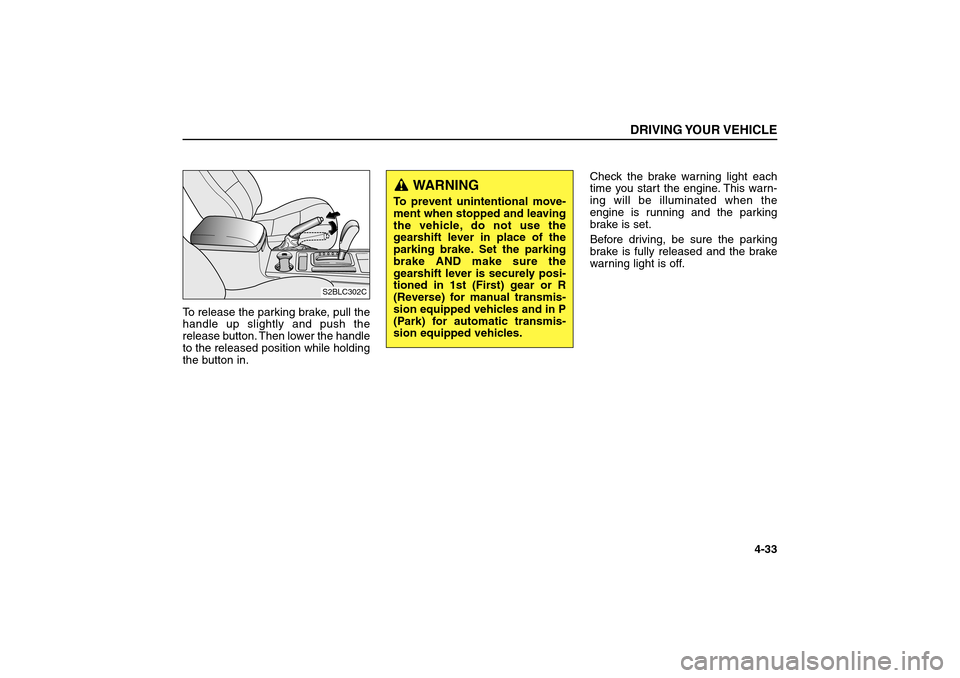
To release the parking brake, pull the
handle up slightly and push the
release button. Then lower the handle
to the released position while holding
the button in.Check the brake warning light each
time you start the engine. This warn-
ing will be illuminated when the
engine is running and the parking
brake is set.
Before driving, be sure the parking
brake is fully released and the brake
warning light is off.
DRIVING YOUR VEHICLE
4-33
S2BLC302C
WARNING
To prevent unintentional move-
ment when stopped and leaving
the vehicle, do not use the
gearshift lever in place of the
parking brake. Set the parking
brake AND make sure the
gearshift lever is securely posi-
tioned in 1st (First) gear or R
(Reverse) for manual transmis-
sion equipped vehicles and in P
(Park) for automatic transmis-
sion equipped vehicles.
BL-ENG (CAN)-4.qxd 7/28/05 5:55 PM Page 33
Page 134 of 312
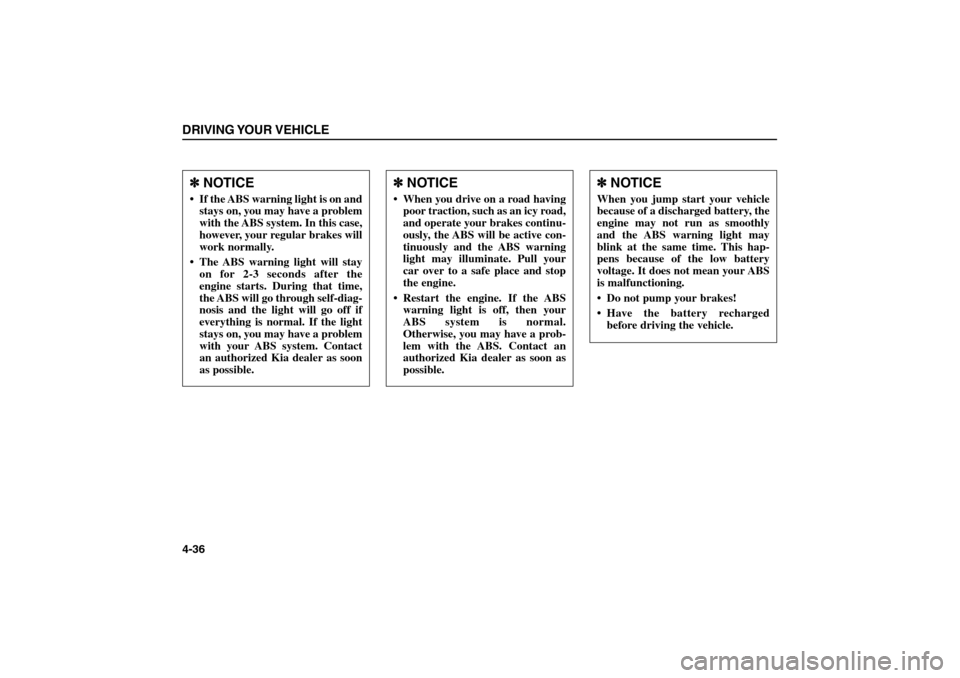
DRIVING YOUR VEHICLE4-36
✽ ✽
NOTICEWhen you jump start your vehicle
because of a discharged battery, the
engine may not run as smoothly
and the ABS warning light may
blink at the same time. This hap-
pens because of the low battery
voltage. It does not mean your ABS
is malfunctioning.
Do not pump your brakes!
Have the battery recharged
before driving the vehicle.
✽ ✽
NOTICE If the ABS warning light is on and
stays on, you may have a problem
with the ABS system. In this case,
however, your regular brakes will
work normally.
The ABS warning light will stay
on for 2-3 seconds after the
engine starts. During that time,
the ABS will go through self-diag-
nosis and the light will go off if
everything is normal. If the light
stays on, you may have a problem
with your ABS system. Contact
an authorized Kia dealer as soon
as possible.
✽ ✽
NOTICE When you drive on a road having
poor traction, such as an icy road,
and operate your brakes continu-
ously, the ABS will be active con-
tinuously and the ABS warning
light may illuminate. Pull your
car over to a safe place and stop
the engine.
Restart the engine. If the ABS
warning light is off, then your
ABS system is normal.
Otherwise, you may have a prob-
lem with the ABS. Contact an
authorized Kia dealer as soon as
possible.
BL-ENG (CAN)-4.qxd 7/28/05 5:55 PM Page 36